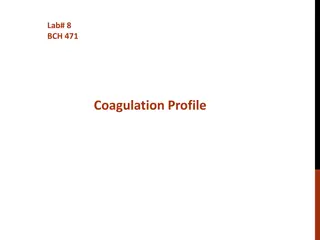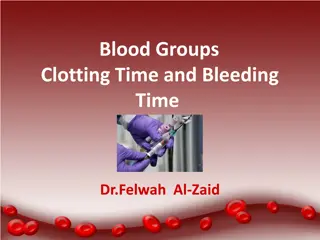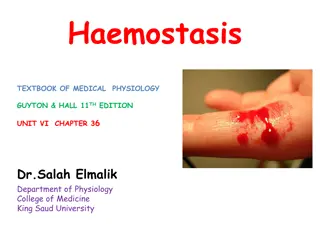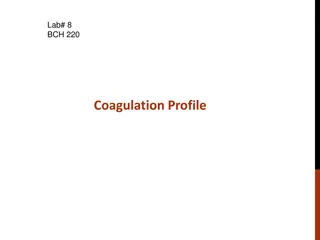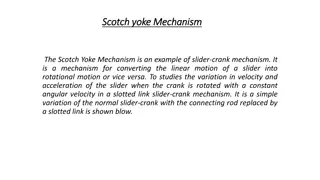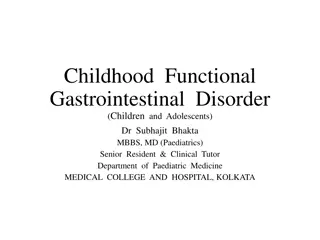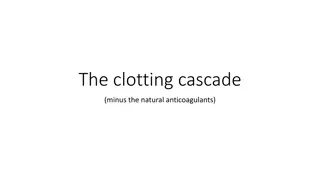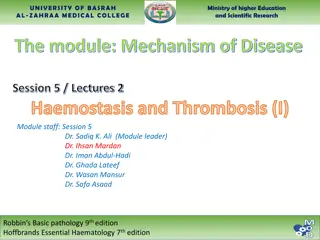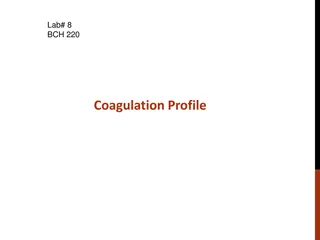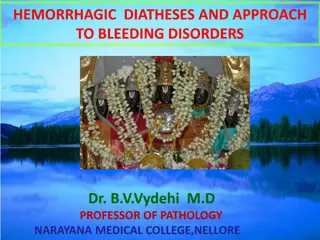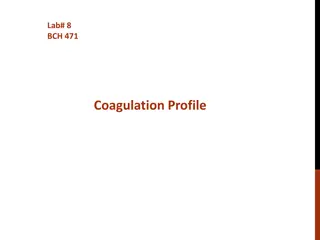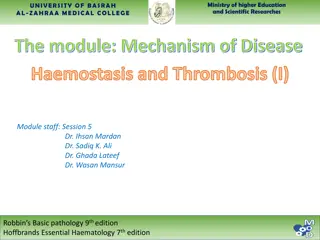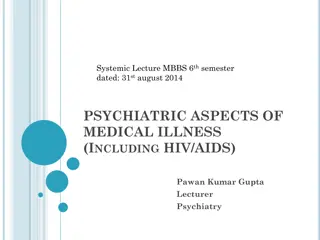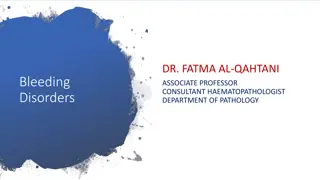Mechanism of Haemostasis & Clotting Disorders
The mechanism of haemostasis, clotting disorders, and clinical & laboratory assessment related to bleeding disorders. Understand the phases of haemostasis - vascular, platelet, coagulation, and fibrinolytic. Learn about the intrinsic and extrinsic pathways of coagulation along with the theories of coagulation mechanism. Discover the role of coagulation factors and fibrinolytic phase in limiting clot propagation. Delve into the clinical and laboratory findings associated with bleeding disorders.
Download Presentation

Please find below an Image/Link to download the presentation.
The content on the website is provided AS IS for your information and personal use only. It may not be sold, licensed, or shared on other websites without obtaining consent from the author.If you encounter any issues during the download, it is possible that the publisher has removed the file from their server.
You are allowed to download the files provided on this website for personal or commercial use, subject to the condition that they are used lawfully. All files are the property of their respective owners.
The content on the website is provided AS IS for your information and personal use only. It may not be sold, licensed, or shared on other websites without obtaining consent from the author.
E N D
Presentation Transcript
Learning Objectives At the end of the lecture student should be able to- Describe mechanism of haemostasis Enlist Clotting disorders Describe clinical & laboratory assessment
Dental procedures resulting in bleeding can have serious consequences in a pt. having bleeding disorder severe hemorrhage or even death.
Vascular phase. Platelet phase. Coagulation phase. Fibrinolytic phase.(rate limiting step)
Circulating blood platelets are activated Aggregates Primary vascular plug( es blood loss from small blood vessels & capillaries) Adheres to exposed basement membrane.
COAGULATION PHASE: INTRINSIC PATHWAY EXTRINSIC PATHWAY COMMON PATHWAY.
2 theories::: Prothrombin to thrombin & fibrinogen to fibrin conversion system ( MARKOWITZ----1903) CASCADE / WATERFALL theory(1964)-the coagulation mechanism results in a final explosive change of a liquid to a gel.
FIBRINOLYTIC PHASE: Propagation of the clot is limited by fibrinolysis. Tissue plasminogen activator(tPA) released from the endothelial cells converts PLASMINOGEN to PLASMIN. Plasmin degrades fibrinogen & fibrin to fibrin degradation products [FDPs] .
CLINICAL CLINICAL & & LABORATARY FINDINGS LABORATARY FINDINGS
CLINICAL LABORATARY TESTS Help to Identify deficiency of required elements Dysfunction of the phases of coagulation Platelet count Bleeding time PFA-100 CT PT/INR aPTT TT FDPs Factor assays Tests of capillary fragility
PLATELET COUNT: Normal-150,000 to 450,000/mm3 If < 50,000/mm3 Hemorrhagic stroke Surgical/traumatic hemorrhage etc. may occur. In such cases platelet transfusion may be necessary. Bleeding time{ 1-6 mins}-modified Ivy s test.
PT & INR Normal-11 to 30 secs its now commonly reported with its INR. INR Intro.by WHO(1983):itz the ratio of PT that adjusts for the sensitivity of the thromboplastin reagants,such that normal coagulation profile is reported as an INR of 1.0
Normal-9 to 13 secs. Measure the activity of heparin,FDPs,other para proteins that inhibit conversion of fibrinogen to fibrin.
CLASSIFICATION OF BLEEDING DISORDERS: Vessel wall disorders. Platelet disorders. Coagulation disorders. CONGENITAL COAGULOPATHIES: HEMOPHILIA A HEMOPHILIA B FACTOR XI DEFICIENCY FACTOR XII ,, FACTOR X ,, FACTOR V ,, FACTOR XIII & I DEFICIENCIES. VON WILLEBRAND S DISEASE.
ANTI COAGULANT RELATED COAGULOPATHIES: Heparin Coumarin. DISEASE RELATED COAGULOPATHIES: Liver disease Vitamin K deficiency DIC Fibrinolytic disorders.
SUMMARY Mechanism of haemostasis Clotting disorders Clinical & laboratory assessment
References Basic Pathology. Kumar, Cortan, Robbin. sixth edition. Shafers Oral Pathology. Basics of hematology. Kwathilkar.3rd edition. Neville Oral Pathology



